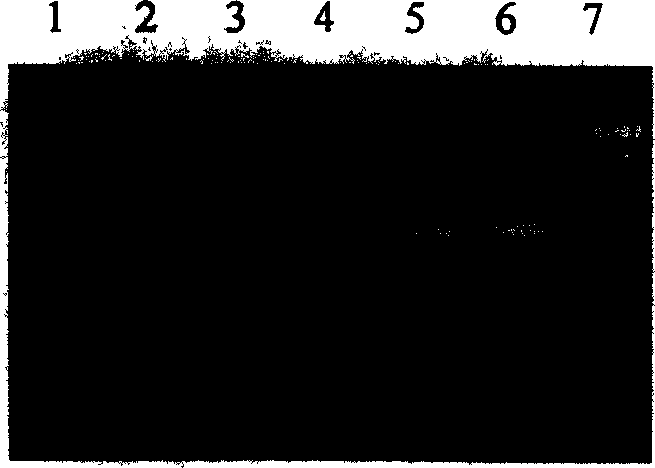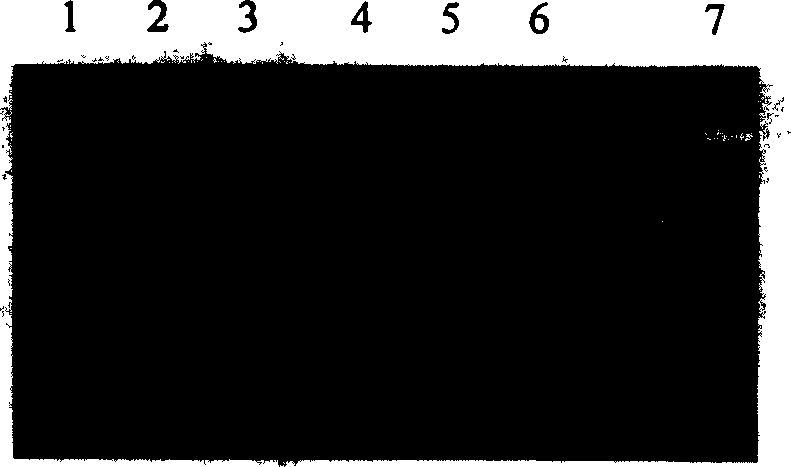Artificial synthetic Bt antiinsect gene used for transgene antiinsect plant and its development method
A gene and insecticidal protein technology, applied in the field of Bacillus thuringiensis Btcry gene and its development, can solve problems such as unclear sequence
- Summary
- Abstract
- Description
- Claims
- Application Information
AI Technical Summary
Problems solved by technology
Method used
Image
Examples
Embodiment 1
[0046] Example 1 Analysis of the insecticidal activity of Cry1Ie1 protein against soybean borer
[0047] Table 2 lists the toxicity analysis of Cry1Ie1 against several pests. The activity against corn borer and diamondback moth has been patented (application number: 01124163.2). The present invention finds that it also has an obvious insecticidal effect on soybean borer.
[0048] Table 2 Analysis of insecticidal activity of Cry1Ie1 protein
[0049] Insect species LC50 (μg / mL) 95% confidence limit
[0050] Corn borer Ostrinia furnacalis 2.22 1.77-2.75
[0051] Plutella xylostella 0.20 0.13-0.27
[0052] Leguminivora glycinivorella 9.02 3.50-23.24
[0053] Helicoverpa armigera >1000 No activity
[0054] Spodotera exigua >1000 inactive
[0055] Pyrrhalta aenescens >1000 inactive
Embodiment 2
[0056] Example 2 PCR amplification of cry1Ie1 genes of different lengths
[0057] According to the full-length cry1Ie1 gene sequence (SEQ ID NO 4), 7 primers were designed to amplify the gene fragments with end deletions. P001, P045, and P105 are upstream primers with NdeI restriction site added; P633, P648, P656 and P659 are downstream primers with SalI restriction site added. The number after the primer is the amino acid number of the primer in cry1Ie1. The sequence is as SEQ ID NO 1.
[0058] Using the plasmid pET-1IE containing the full-length cry1Ie1 gene as a template (Patent Application No. 01124163.2), the upstream and downstream primers were combined respectively to perform PCR amplification to obtain gene fragments of different lengths (Table 3). The reaction system is as follows: PCR 10 Buffer 10μL, 20mmol MgCl 2 12μL, 10mmol dNTP2μL, 10μmol upstream and downstream primers each 2μL, DNA template 0.1-2ng, 2U pfu enzyme 0.5μL, make up to 100μL with ultrapure water, mix an...
Embodiment 3
[0068] Example 3 Construction of expression vectors for cry1Ie1 genes of different lengths
[0069] The cry1Ie1 gene fragments of different lengths (such as Figure 1a ), insert these gene fragments into pET-21b (purchased from Novagen) to obtain recombinant plasmids with these fragments (such as Figure 1b ), and through sequencing, it was proved that the obtained sequence was identical to the cry1Ie1 gene sequence, and BL21(DE3) (purchased from Novagen) was transformed to obtain a recombinant engineering bacteria.
PUM
 Login to View More
Login to View More Abstract
Description
Claims
Application Information
 Login to View More
Login to View More - R&D
- Intellectual Property
- Life Sciences
- Materials
- Tech Scout
- Unparalleled Data Quality
- Higher Quality Content
- 60% Fewer Hallucinations
Browse by: Latest US Patents, China's latest patents, Technical Efficacy Thesaurus, Application Domain, Technology Topic, Popular Technical Reports.
© 2025 PatSnap. All rights reserved.Legal|Privacy policy|Modern Slavery Act Transparency Statement|Sitemap|About US| Contact US: help@patsnap.com



